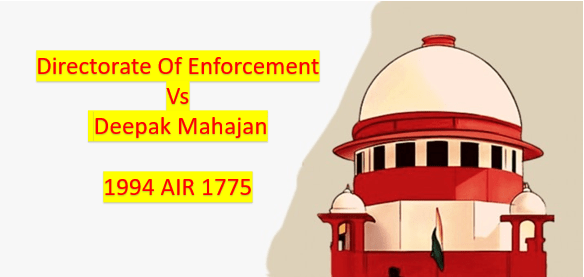
Directorate Of Enforcement vs Deepak Mahajan 1994 AIR 1775
Case Name : | Directorate of Enforcement Vs. Deepak Mahajan and another |
| Equivalent Citation: | AIR 1994 SC 1775 |
| Date of Judgement: | 31 January, 1994 |
| Court: | Supreme Court of India |
| Case No.: | 537/1990 |
| Case Type : | Criminal Application |
| Petitioner: | DIRECTORATE OF ENFORCEMENT |
| Respondent: | DEEPAK MAHAJAN |
| Bench: | Hon’ble Mr. Justice Ratnavel Pandian Subbiah And Justice K.JAYACHANDRA REDDY |
| Refered: | Criminal Procedure Code 1973Foreign Exchange Regulation Act (FERA) 1973Custom Act , 1962 |
FACTS OF THE CASE
The Directorate of Enforcement, the petitioner in this case, had issued a show-cause notice to Deepak Mahajan, the respondent. The notice was issued under the provisions of the Foreign Exchange Regulation Act (FERA), 1973. The notice alleged that Deepak Mahajan had contravened the provisions of FERA by acquiring foreign exchange through unauthorized means and had failed to repatriate the foreign exchange as required by law. The Enforcement Directorate officers detained Deepak Mahajan, the respondent, for a violation of the FERA’s provisions, and he was brought before the Additional Chief Metropolitan Magistrate of New Delhi the following day as required by Section 35’s subsection (2). The Enforcement Officer filed a request for petitioner’s “judicial remand” under Section 167(2) of the Code of Criminal Procedure Code[i] on the justification that it was required to complete the investigation. The respondent attempted to get bail granted in court that same day but was denied. The first respondent was placed in judicial imprisonment for fourteen days by the magistrate, who then prolonged the detention period. The first respondent contested the magistrate’s authority in approving both the initial remand and all subsequent extensions. However, his appeal was turned down as a result of the Gupta case ruling[ii]. The Supreme Court heard the matter in the end.
ISSUES RAISED
- The primary issue in this case was whether Deepak Mahajan had indeed contravened the provisions of FERA and if so, what would be the appropriate action or penalty to be imposed.
- Whether the Special Leave Petition is maintainale.
- The Enforcement Directorate under FERA (now FEMA) or Custom’s Act is a competent person to take judicial remand of an arrested person.
CONTENTIONS OF THE PETITIONER
- The Directorate of Enforcement argued that Deepak Mahajan had contravened the provisions of the Foreign Exchange Regulation Act (FERA) by acquiring foreign exchange through unauthorized means and failing to repatriate it as required by law.
- The petitioner contended that Deepak Mahajan’s actions were in violation of FERA, which aims to regulate and control foreign exchange transactions in the country.
- The petitioner presented evidence to support its allegations and emphasized the seriousness of the offense and its impact on the economy.
CONTENTION OF THE RESPONDENT
- Deepak Mahajan, the respondent, likely presented a defense against the allegations made by the Directorate of Enforcement.
- His defense might have included challenging the evidence presented by the petitioner and arguing that he did not contravene the provisions of FERA.
- Deepak Mahajan might have presented any mitigating circumstances or justifications for his actions, attempting to show that he did not have any criminal intent or that there were extenuating circumstances that should be considered.
JUDGEMENT
In the case of Directorate of Enforcement vs Deepak Mahajan (1994 AIR 1775), the judgment of the court was delivered by S. Ratnavel Pandian, J. The salient legal question for determination in this appeal was whether a Magistrate, before whom a person arrested under subsection (1) of Section 35 of the Foreign Exchange Regulation Act (FERA) of 1973, has the jurisdiction to authorize the detention of that person under Section 167(2) of the Code of Criminal Procedure (CrPC). The court examined the provisions of FERA, specifically Section 35(1) which allowed the arrest of a person by an authorized officer if there are reasonable grounds to believe that the person has committed a contravention under the Act. The court noted that Section 35 of FERA is in pari materia (similar) with subsection (1) of Section 104 of the Customs Act of 1962. The court also considered the provisions of Section 167(2) of the CrPC, which deals with the power of a Magistrate to authorize the detention of an accused person during the course of an investigation. After a thorough analysis, the court held that a Magistrate, before whom a person arrested under subsection (1) of Section 35 of FERA is produced under subsection (2) of Section 35, does have jurisdiction to authorize the detention of that person under Section 167(2) of the CrPC. The court reasoned that since the provisions of Section 35 of FERA are in pari materia with the provisions of the Customs Act, the powers and procedures available under the CrPC would be applicable to FERA cases as well. This judgment clarified the jurisdiction of the Magistrate in cases where a person is arrested under FERA and whether the Magistrate has the authority to order their detention under the CrPC. The court’s decision provided legal certainty and established the compatibility of the procedural provisions between FERA and the CrPC in relation to detention.
CONCLUSION
The decision made in this case is unequivocally valid. Instead of using a strict reading of the law, it is critical to focus on the legislature’s intentions. The Supreme Court is correct to hold that we must pay close attention to the task of correctly applying the relevant law by determining the intended meaning of the language used and the legislative intent, rather than simply giving it a strict reading.
written by Tushar Khandekar intern under legal vidhiya




0 Comments